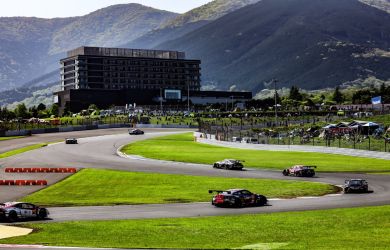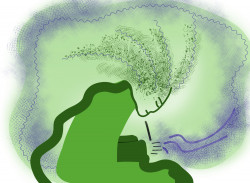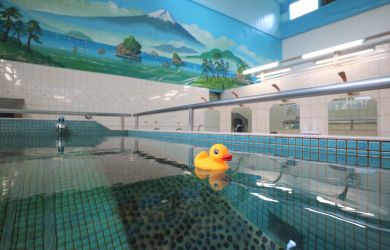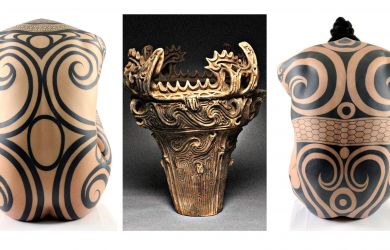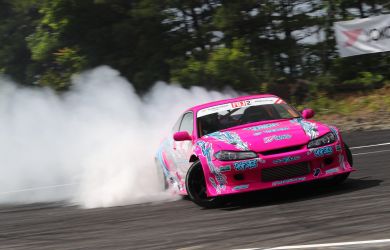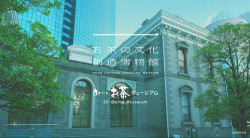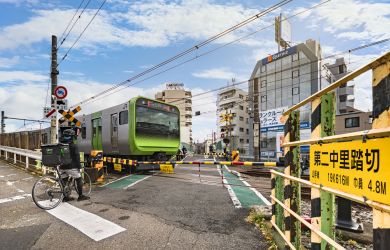
December 17, 2009
Down By the River
Monzen-Nakacho offers vibrant attractions—and a slower pace—just across the Sumidagawa
By Metropolis
Originally published on metropolis.co.jp on December 2009
The Monzen-Nakacho neighborhood—“Mon Naka” to locals—seems perpetually locked between different worlds: between glitzy Ginza boutiques and the humble suburban sprawl of Chiba prefecture; between rustic postwar tenements and the gleam of Odaiba’s futuristic architecture. Frequently a stopover point to nearby destinations such as Ryogoku’s Edo-Tokyo Museum or Kiba’s Museum of Contemporary Art, the area actually satisfies as a destination in itself. It’s only ten minutes from Tokyo station and the Marunouchi and Nihombashi business districts, but this cozy little nook of the metropolis gives the best of what shitamachi has to offer: broad sidewalks, tree-lined waterways and a lazy, old-Tokyo ambiance.
Also known as Fukagawa, the area between Monzen-Nakacho and neighboring Kiyosumi-Shirakawa station is a canal district. Most of these waterways are lined with cherry trees, making them an ideal place for an idle stroll most of the year. Of course, hanami season is the best time to wander under the canopy and stop to enjoy the local festival welcoming the pink petals of spring. There are boat rides on offer, but it’s just as enjoyable to stand on the bridges with a coffee or locally brewed beer and watch traditional musicians performing as they pass by on the water below.
A number of interesting temples and shrines dot the area, the two most famous being Fukagawa Fudoson Temple and Tomioka Hachimangu Shrine, which are both just off the main Eitai Dori thoroughfare. Follow this road east a few blocks from the station, and you’ll come upon the orange torii of Fukagawa Fudoson. Turn left through the gate, and the road switches from asphalt to roughly hewn stone. This path goes straight to the temple, but walk slowly and make time to peruse the small tea shops along the way. Ceremonies at Fukagawa Fudoson can be quite loud and are worth getting close to, so if you hear pounding drums from the gate, you’ll know you’re in luck.
A few blocks further east is Tomioka Hachimangu, which is popular among Japanese tourists, in part because it is one of the ancestral homes of sumo. Tournaments took place here during the Edo period, and many wrestlers still come to be blessed during the New Year holidays. As you face the main building, follow the small path to the right under the temple’s covered walkway and you’ll approach a monument with the images of wrestlers engraved on two columns. Built in 1900, these massive stones have the names of all the yokozuna chiseled into their sides. Make sure to look on the back of the monument to see where the newest grand champions are carved—the most recent is Hakuho, the 69th yokozuna. The blank spaces to the left of his name await the next grapplers to advance.
Hachimangu is also home to some of Japan’s largest mikoshi. These large wooden portable shrines are said to house the gods during the Fukagawa Hachiman Matsuri, a local festival that happens every three years (the next one is in 2011) and is considered to be one of Tokyo’s top three in terms of size and attendance. Each neighborhood is represented by their own portable shrines, which are then carried by thousands of residents. An estimated 500,000 people come to watch and throw water onto the participants, cooling them down during the stifling heat of summer.
Hachimangu’s two massive mikoshi do not participate in this ritual, unfortunately—they’re simply too heavy (over 4 tons) and too expensive. Covered in gold and jewels, they’re estimated by some to be worth over ¥1 billion. But the shrines are on display most days. As you walk toward the front of Hachimangu, they’re in the covered building to your left. Make sure to check out the golden phoenix on top and the diamonds placed into the eyes of golden dog-like creatures that decorate the periphery. The mikoshi are usually shuttered up around 4 or 5pm.
The shrine also hosts an interesting antique fair every first, third and fourth Sunday. This can be a fantastic place to pick up souvenirs for friends back home: lacquerware, tea sets and other ceramics are on display, but there are plenty of other small and reasonably priced items that won’t risk breaking in your suitcase. Peruse the rows and rows of fountain pens for the business-minded on your list, or sort through boxes of jewelry, handbags and hairpins for a stylish accessory. For unusual bits of Japanese ephemera, check the stalls selling old toys, scrolls, magazines and movie posters. The prices and quality of the posters vary dramatically, but if you take a few minutes to flip through the stacks, you are bound to find at least one keeper, whether it be from a Godzilla movie, a samurai flick or some forgotten Showa-era romantic comedy.
For some edible souvenirs, try Minatoya, which is situated on Eitai Dori between the Fukagawa Fudoson temple and the train station. It’s hard to miss—baskets of senbei in countless shapes, colors and flavors spill out over the sidewalk, and there is usually someone baking a fresh batch at the entrance. After tasting the samples, you may be ready for lunch. Shimada, an udon specialty restaurant, is just around the next corner. The owners have converted the front window into an open work station, so you can see your noodles being rolled, stretched and cut right before you eat them. The menu here has plenty of pictures, making it easy to order. The udon and tempura portions are quite large, but save some room for their teba-gyoza: chicken wings stuffed with a mixture of pork, scallions and garlic.
Now that your stomach is well filled, it’s time to see the nearby gardens and galleries—but first, a brief visit to the underworld. Walk north on Kiyosumi Dori, pass under the highway bridge, and Fukagawa Enma-do is the red temple one block down on the right. Enma is essentially the god of the dead, and the chamber dedicated to him (center, ground level) is covered floor-to-ceiling with re-creations of ancient scrolls depicting those who have left this world and the trials and judgments they endure. Some images are gory, others darkly humorous (think Hieronymus Bosch of the Far East). Take a moment to watch the large plasma screen showing a video explaining the imagery you see. You don’t have to speak a word of Japanese to know that some of those souls are in deep trouble.
After this sneak peak of hell, it’s time for a bit of heaven on earth. Keep walking north on Kiyosumi Dori until you reach Kiyosumi Teien on the left. This beautifully manicured garden and pond has plenty of turtles, ducks and duck-sized koi so tame you can literally pet them. If you need further proof, buy a pack of bread at the on-site snack stall inside. The garden was owned by several Edo-period merchants and lords until Iwasaki Yataro, the founder of Mitsubishi Corporation, acquired it in 1878. It would have been an incredible place to entertain employees and dignitaries, and now makes an ideal location to relax and enjoy a moment of peace in the city. The garden’s flower calendar runs from January to August, and the maples begin to turn fire-red a month or so after that. If you go in June, however, make sure to check out the iris garden blooming in a small courtyard behind the teahouse.
After taking in all this beauty, you’ll be ready to indulge your aesthetic sense at the Kiyosumi gallery complex a few blocks away. Exit Kiyosumi Teien and walk down the central path of the adjoining public park, Kiyosumi Koen. Cross the street on the other side, and between a cement factory and a taxi filling station is a large white warehouse. On the top three floors of this building you’ll find some of the most respected contemporary art galleries in Japan. Take the massive three-door elevator upstairs and meander down, making sure to poke your head in at the Taka Ishii Gallery, Hiromi Yoshii Gallery and Tomio Koyama Gallery. All three are serious international players, participating in many of the world’s most prestigious art fairs.
If you’re in the mood for more cutting-edge culture, the Museum of Contemporary Art, Tokyo is a 20-minute walk east. Make your way back through the park and past Kiyosumi Teien to Kiyosumi Dori. Across the street you’ll see two old wooden lanterns flanking the road. This street runs straight to Kiba Koen, with the museum at its northernmost end. If that’s too far to walk, the same street has a number of nearby temples and shrines worth wandering through. Also on this street is the Fukagawa Edo Museum. Not to be confused with the much larger and more famous Edo-Tokyo Museum in Ryogoku, this local branch houses its own reconstructed Edo-era village, but will be closed for refurbishing until the summer of 2010.
On the south side of Monzen-Nakacho, the Sumida River sets a lazy pace. From the station, head south on Kiyosumi Dori on the right-hand side of the road. Take a right just past the large anchor monument and you’ll arrive at Etchujima Koen, a narrow strip of greenery facing the water with the Blade Runner-like apartment towers of Tsukishima on the far bank.
Located at the fork in the river, this is also the home of one of the city’s water bus stations. From here, you can catch boats that can take you to Odaiba and Hamarikyu Gardens (both recommended) or even as far as Kasai Rinkai Koen, the massive park and aquarium near Tokyo Disneyland (avoid—too long and expensive). In the evenings, dozens of yakatabune use the Echujima dock as a landing station to pick up large groups for all-you-can-eat and -drink parties as they float to Odaiba. These trips are arranged in Tsukishima on the other side of the river, but it may be more enjoyable to sit on the shore and watch the sun set as these lantern-festooned boats slowly float into the distance, the sound of their karaoke rippling over the water.
All this walking has probably helped you work up an appetite, so head back up to Monzen-Nakacho station, cross Eitai Dori, and turn left. Just past exit 3 of the station are the stairs to Tsumami-na, a restaurant specializing in both tofu dishes and meat and vegetable kushiage. Everything on the menu is tasty, and there are plenty of pictures to point to if you’re unsure what to try next.
If you’re feeling more adventurous, cross to the opposite corner of the intersection and follow the street behind a massive pachinko parlor for about a block. You have now arrived at one of Monzen-Nakacho’s main eating and drinking areas. This street and the one running parallel to it are packed with small izakaya and open-grill restaurants specializing in beef, seafood or offal meats like liver and tongue. Whether you eat on this street or not, the bright and lively atmosphere alone makes it worth the walk.
Perhaps you’d like something with a little more class? If so, the drag is bookended by two exceptional cocktail bars. The tuxedo-clad staff in these lounges are true professionals, creating drinks that are beautiful objects in their own right.
The closest to Kiyosumi Dori is Bar C, its nondescript white exterior hiding the dark wood and fresh flowers within. The mint juleps and old fashioneds come recommended, but if you are a bourbon fan, their selection covers the entire spectrum, from sweet to peaty. Several blocks east and just across from the Hachimangu shrine is Bar OPA on the second floor. Its main branch in Ginza boasts a number of international bartending awards, but since the owner lives in the Monzen-Nakacho area, he decided to open a branch closer to home. Drinks at both places start at ¥900, and you should expect a ¥1,000 seating charge.
For a drinking experience that’s more reasonably priced and in tune with the area’s working-class roots, belly-up to the bar at Nihon Saisei Sakaba, located on Eitai Dori one block west of the Kiyosumi Dori intersection and exit 4 of Monzen-Nakacho station. This tachinomiya tries to recreate the feeling of the postwar Showa period: transistor radios play enka and ’60s pop, an old black-and-white TV broadcasts news clips and wrestling matches from a bygone era, and the walls look like they’re decorated with movie posters from the nearby antique market. Draft beer, sake and shochu are on offer, and the yakitori and other meats—both grilled and raw—are expertly prepared. Watch the time, however: Nihon Saisei Sakaba tends to close around 11pm.
Monzen-Nakacho offers an attractive retreat from the frantic pace of city life. By straddling Tokyo’s past and future, the neighborhood represents the best of both.
Getting there: Monzen- Nakacho station is on the Tozai and Toei Oedo lines.
1. Fukagawa Fudoson Temple
1-17-3 Fukagawa. Tel: 03-3641-8288. www.fukagawafudou.gr.jp
2. Tomioka Hachimangu Shrine
1-20-3 Tomioka. Tel: 03-3642-1315. www.tomiokahachimangu.or.jp
Hachiman Antique Market
Tomioka Hachiman shrine. Held every first, second and third Sunday of the month (closed when those days fall on the 15th and 28th). Address above. www.kotto-rakuichi.com/tomi.html
3. Minatoya
2-4-9 Monzen-Nakacho. Tel: 03-3641-1752. Open daily 10am-6pm. www.minatoya.biz
4. Shimada
1-8-2 Tomioka. Tel: 03-3630-6565. Open Mon-Fri 11am-4pm and 5:30-10pm, Sat 11am-4pm and 5:30-9:30pm, Sun & hols 11am-4pm and 5:30-9pm.
5. Fukagawa Enma-do
2-16-3 Fukagawa. Tel: 03-3641-1652. Open daily 9am-5pm. www.enma.or.jp
6. Kiyosumi Teien & Kiyosumi Koen
3-3-9 Kiyosumi. Tel: 03-3641-5892. Open daily 9am-5pm (last entry 4:30pm).
7. Kiyosumi gallery complex
1-3-2 Kiyosumi. Open Tue-Sat. noon-7pm, closed Sun-Mon & hols.
Taka Ishii Gallery (5F). Tel: 03-5646-6050. www.takaishiigallery.com
Hiromi Yoshii Gallery (6F). Tel: 03-5620-0555. www.hiromiyoshii.com
Tomio Koyama Gallery (7F). Tel: 03-3642-4090. www.tomiokoyamagallery.com
8. Museum of Contemporary Art, Tokyo
4-1-1 Miyoshi. Tel. 03-5245-4111. Open Tue-Sun 10am-6pm, closed Mon. www.mot-art-museum.jp
9. Fukagawa Edo Museum (closed until July 2010)
1-3-28 Shirakawa. Tel: 03-3630-8625. Open daily 9:30am-5pm, closed every 2nd and 4th Mon. www.kcf.or.jp/fukagawa
10. Etchujima Koen
1-3 Etchujima. Tel: 03-3647-9111. www.date-navi.com/yakei/etyuuzima.html
Water bus station
1-3 Etchujima. www.tokyo-park.or.jp/waterbus/course/port/ecchu.html
11. Tsumami-na
2F, 1-7-11 Monzen-Nakacho. Tel: 03-3630-3996. Open daily 11am-3pm and 5pm-midnight. http://r.gnavi.co.jp/g580600
12. Bar C
2-3-14 Monzen-Nakacho. Tel: 03-6411-0659. Open Tue-Sat 5pm-3am, Sun 5pm-midnight, closed Mon.
13. Bar OPA
2F, 1-25-4 Tomioka. Tel: 03-5245-3539. Open Mon-Sat 6pm-4am, closed Sun.
14. Nihon Saisei Sakaba
1-4-3 Monzen-Nakacho. Tel: 03-5621-5229. Open 5pm-11pm.
A fantastic time to visit Monzen-Nakachi is during the Fukagawa Sakura Festival, which will take place Mar 21-Apr 12. See www.mon-naka.com/sakura for more information.
View Monzen-Nakacho on a map








